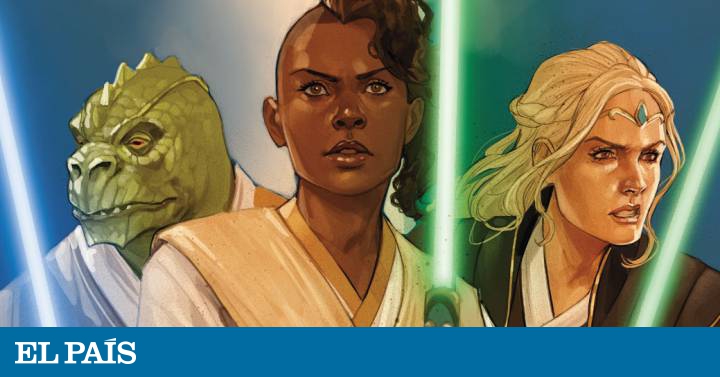Actually, the plan is not new.
But the way to deploy it is;
radically.
Star Wars is
going to attempt, once and for all, the most intense and necessary effort that its mythology needs to undertake: to retire the Skywalkers.
The High Republic
, a new era within the
Star wars
universe
that now lands with novels, comics and that in the very near future will give the true heart so that this simple maxim, simple in its enunciation, asserts its reality.
The Skywalker's force of gravity has been both a blessing and a curse for the Star Wars universe.
His latest film, which left a bitter aftertaste despite achieving more than 1,000 million dollars at the box office, led the Skywalkers, for the first time, to the title (
Rise of the Skywalker
), a symptom of the roots that these characters have for multiple generations, to the point that this last name overshadowed the extraordinary universe that framed them.
The funny thing is that in parallel to this dependence on the Skywalkers, Star Wars, for the true fans, who are also millions, although not hundreds of millions, lived, from a very early date, beyond the Skywalkers.
The miracle is due to a series of creators, revered by proselytes and unknown to the general public, who created an infinite plot of comics and video games that, in the eyes of this minority (including myself), competed if not vastly exceeded what was achieved in the original trilogy.
Works like the video game Star wars.
Knights of the Old Republic
or novels like
Timothy Zann's
Heir to the Empire
are small with a large necklace that grew in parallel to the Skywalker soap opera.
But everything has changed thanks to a monumental success that nobody expected: that of the Mandalorian and the little Baby Yoda.
For the first time, it was shown that Star Wars, even sutraid of lightsabers (until this second season) and starring secondary characters who lived adventures parallel to the great plots where the fate of the galaxy and the force was played, had a power such as to cast a spell on a mass audience.
The Mandalorian has been the ending, in short, of that idea behind the expanded universe that lived its life in parallel for decades.
The next step to that conquest, after reconciling the two sides of Star Wars in the historic episode The Rescue of the second season of The Mandalorian, is to raise this new status quo in the mythology of Star Wars: The High Republic.
A spectacular page from the first issue of 'La Alta República'.
And what, exactly, is this new status quo?
Judging by the 24 pages of this first issue,
The High Republic
is a return to Star Wars more focused on the adventuresque, with the multicultural in the spotlight and the emphasis on collective protagonism.
In this first issue (written by Cavan Scott and illustrated by Indonesian Ario Anindito) the letters unfold from the cover.
The protagonist (although without any aura of chosen to the Skywalker) is a young black woman with a very contemporary hairstyle, shaved head on one side and long hair on the other, the setting of the story is an old triumphant republic (it takes place two centuries before the events of the first Skywalker saga), which sends probes to spread its message of light across the galaxy and the rhythm and adventures are cheerfully shameless.
There are giant cosmic locusts, a city of little pixies in danger of being razed, and constant action sequences.
And a small cameo, the only concession to the wink: a Yoda two hundred years younger than the one we saw in the Lucas trilogies.
An exciting page that supports the message of collective and multicultural protagonism of 'La Alta República'.
As an agape, what these 24 pages contain is tremendously promising.
First, because its environment no longer tries to replicate the look of the old films that so weighed down the last trilogy;
in a sense, it is soaked in that festive and colorful spirit that predominated in the best passages of
Episode I, II
and
III,
a more alive, exotic and creaturely galaxy.
The scriptwriter himself confidently reveals the spirit of the pages in a brief message to the reader after the adventure: "It has everything you should ask of a Star Wars comic: mind-blowing lightsaber battles, fearsome villains, overwhelming Space battles, friendships that will warm your heart, and devastating betrayals that will break your heart in the next minute. Oh, and there are monsters. Many, many monsters. "
Not Lucas's grim seriousness in
Episode I, II,
and
III,
or Abrams's fearful reverence for the Skywalkers in Chapters
VII
and
IX
.
Simply embrace the spirit.
Second, because it embraces collective leadership.
There are many Jedi and the protagonist is one more;
not a Harry Potter or Anakin Skywalker embraced by a prophecy.
One more in a group of fighters for justice.
Scott and Anindito visualize this fact on a truly exciting page, the last of the comic, where The High Republic underpins a message that filmmaker Rian Johnson already gave in the extraordinary and reviled
Episode VII
: anyone can be a hero of the galaxy.
The Force belongs to everyone.
Here are eyes eager to see how that verb becomes flesh. Or, in this case, bullets.









